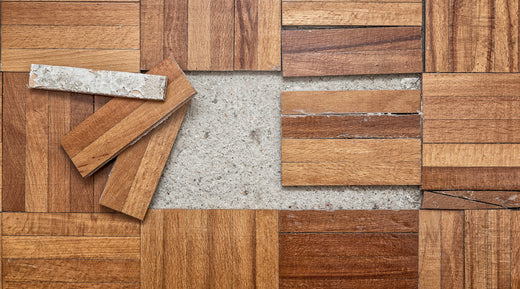Can You Repair Water-Damaged Hardwood Floors?
Posted by WOCA WOODCARE

Water damage is one of the most common and costly problems a homeowner can face. Beyond structural issues and potential mold growth, it can also cause serious harm to your hardwood floors.
The big question is: Can you repair water-damaged hardwood floors?
The answer depends on the extent of the damage — but in many cases, repair and refinishing are absolutely possible.
Why Water Damages Hardwood Floors
Unlike outdoor wood surfaces, interior wood flooring isn’t treated to handle excess moisture. While a deck might resist rain and sunlight, indoor floors can easily warp or stain when exposed to water.
Common sources of water damage include:
-
Flooding or plumbing leaks
-
Steam from hot showers or humid rooms
-
Spills and standing water left uncleaned
-
Moisture from air conditioners or appliances
Even small spills can penetrate the wood grain, leading to warping, cracks, or water stains over time.
Recognize the Signs of Water-Damaged Hardwood Floors
Detecting water damage early can save your wood floors from more serious problems. Look out for these common symptoms:
-
Warping or buckling: When wood fibers absorb too much water, they expand and lift.
-
Discoloration: Notice dark spots or uneven tones? Water can carry dirt or tannins into the wood pores, leaving stains behind.
-
Soft or spongy boards: Prolonged exposure to moisture weakens wood’s structure.
- Mold or mildew: Moist environments promote mold growth, often accompanied by a musty odor.
If you notice any of these signs, act quickly to prevent further damage or costly floor replacement.

How to Assess and Repair Water-Damaged Hardwood Floors
Before you jump to replace boards, determine how severe the damage is. If your floorboards aren’t warped or buckled and the floor’s finish hasn’t completely failed, follow these repair steps:
1. Clean the affected area:
-
Use a high-quality wood cleaner such as WOCA Intensive Wood Cleaner to remove dirt, dust, and contaminants.
- Wipe with a tack cloth or soft dish cloth to keep the wood surface smooth.
2. Lightly sand the damaged area:
- If stains or shallow scratches are visible, use fine-grit sandpaper or a sanding block to smooth the surface.
- Always sand lightly with the grain — avoid deep sanding unless the boards are severely damaged.
3. Repair cracks or scratches:
-
For deeper scratches, use wood filler or matching wood stain to blend with your existing floor color.
- A putty knife or small brush helps you apply filler evenly across the affected area.
4. Refinish the floor:
-
Apply a protective wood finish, such as WOCA’s oil-based or water-based polyurethane, to seal and restore shine.
-
Use a paint brush or roller to spread multiple thin coats evenly.
- Allow each coat to dry completely and lightly sand between coats for a smooth, durable surface.
When to Call a Professional
If you notice extensive water damage, structural issues, or multiple boards affected, replacement may be your only option.
A professional contractor can:
-
Inspect the subfloor for trapped moisture.
-
Replace damaged planks with prefinished boards that match the existing floor.
- Help you choose between refinishing hardwood floors or installing new wood flooring.
In many cases, professional refinishing can restore the natural color and smooth texture of your wood floors, saving time and cost compared to a full replacement.
Tips to Prevent Future Water Damage
Keeping your hardwood flooring protected year-round takes only a few simple habits:
-
Clean spills immediately — don’t let water sit on the surface.
-
Avoid wet mopping; use a slightly damp cloth or WOCA Natural Soap for routine cleaning.
-
Maintain indoor humidity between 40–60% to prevent wood expansion.
-
Reapply wood oil finishes periodically to nourish and protect the grain.
- Use area rugs or mats in kitchens and bathrooms to catch moisture before it reaches the wood.
Restore Your Hardwood Floors with WOCA
Water damage doesn’t have to mean replacing your entire floor. With early detection, proper cleaning, and professional-grade wood care products, you can repair hardwood floors and restore their natural beauty.
WOCA Denmark offers plant-based oils, soaps, and cleaners specifically designed to protect wood flooring from excess moisture and wear.
Ready to restore your hardwood floors? Shop WOCA Interior Wood Care Products today and give your floors the protection they deserve — naturally beautiful, durable, and built to last.
SHARE:

